Mars Global Movies
Mars Space Flight Facility scientists and researchers are creating movies out of datasets that cover all of Mars. The goal is to explore a new way to use various all-Mars datasets collected by spacecraft. Wrapping datasets around a Mars globe that shows the basic landforms lets scientists study how various properties relate on a global scale.
The global tour provides an overview of eight datasets, each of which is available (links below) as stand-alone video clip.
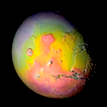
Mars Global Datasets Tour
The data in the video show the telescopic view of Mars from Earth, the planet's albedo (brightness), its color, its topography, its ancient magnetism, its abundance of elemental potassium, its thermal inertia, and its global mineralogy. Then the scene zooms in, eventually stopping at Syrtis Major, a large, low volcano.
Download (1:23, Quicktime, 28.5M) or watch on YouTube
Mars Telescopic View 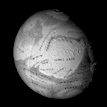
This video clip shows the work of British artist and amateur astronomer Nathaniel Green (1823-1899) from the favorable 1877 opposition. The labels are upside down because Green's observations, published in the Memoirs of the Royal Astronomical Society for 1877-79, place south at top, matching the view in a telescope.
Download (0:34, Quicktime, 6.4M) or watch on YouTube
 Mars Albedo
Mars Albedo
This video shows the global visual albedo (brightness) variations across Mars, as recorded by the Thermal Emission Spectrometer (TES) on NASA's Mars Global Surveyor orbiter.
Download (0:34, Quicktime, 5.4M) or watch on YouTube
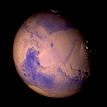 Mars Color
Mars Color
Between 1976 and 1982, NASA's twin Viking Orbiter spacecraft made the first pole-to-pole image survey of Mars in color. Those images are here wrapped around a shaded-relief globe showing the planet's topography.
Download (0:34, Quicktime, 5.7M) or watch on YouTube
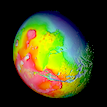 Mars Topography
Mars Topography
The Mars Observer Laser Altimeter (MOLA) instrument on NASA's Mars Global Surveyor made the best map of Martian topography to date. Colors show elevations — "sea level" lies where yellow turns to green — while MOLA data and shading reveal the planet's basins, volcanos, and valleys.
Download (0:34, Quicktime, 7.2M) or watch on YouTube
Mars Remanent Magnetism 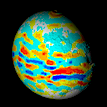
Today Mars has no global magnetic field. However, some areas of ancient terrain have traces of the field that was active when the rocks formed. Red shows where the strongest residual magnetism lies.
Download (0:34, Quicktime, 9.4M) or watch on YouTube
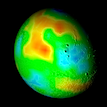 Mars Elemental Abundances
Mars Elemental Abundances
The Gamma-Ray Spectrometer (GRS) on NASA's Mars Odyssey orbiter has mapped the abundance of numerous elements (here: potassium) in the shallow subsurface layers.
Download (0:34, Quicktime, 5.5M) or watch on YouTube
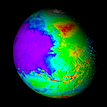 Mars Thermal Inertia
Mars Thermal Inertia
Thermal inertia is the resistance of materials to temperature changes. Solid rock and hard sediments have high thermal inertia values (mapped in warm tones), while sand and dust have lower values (cool tones).This data set comes from the Thermal Emission Spectrometer (TES) on NASA's Mars Global Surveyor orbiter.
Download (0:34, Quicktime, 7.7M) or watch on YouTube
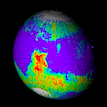 Mars Mineralogy
Mars Mineralogy
Data from the Thermal Emission Spectrometer (TES) on NASA's Mars Global Surveyor orbiter, taken at 10 infrared wavelengths, lets scientists create maps showing where various types of mineral predominate at the Martian surface. This globe shows the distribution of the igneous mineral plagioclase feldspar, an important component of basalt rock.
Download (0:34, Quicktime, 13.2M) or watch on YouTube